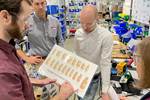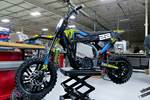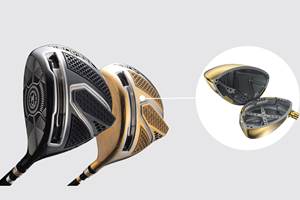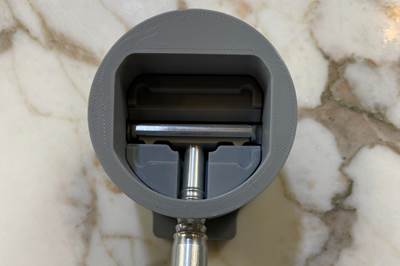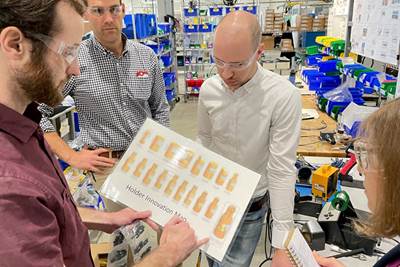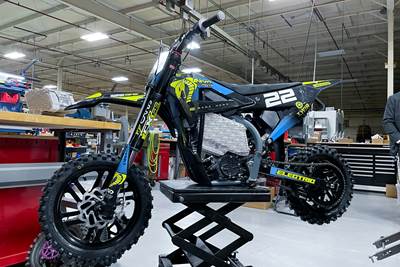Bridge Production Is Real Production
Not prototyping — it is something far more than this. The chance to launch the product into the world using additive manufacturing as the initial process delivers important new possibilities, and even keeps on delivering advantages far into the product’s life.
We are watching additive manufacturing find its place as an accepted and established method for making production parts. We are also watching additive manufacturing realize new possibilities in terms of engineered geometries — the elaborate forms, and customized forms, that can only be made through AM. However, another way to see AM realizing new possibilities is in the products that never would have come to market without it, because of the way 3D printing permits both fast speed to market and bringing the product to market without the investment and commitment needed for production tooling.
Enter bridge production: an important promise of AM. Throughout many stories we have covered recently, bridge production is the theme. Production applications in this category involve producing with AM first — using AM as the bridge — with conventional production processes expected to come later. And the reasons to use AM at the outset in this way are many. They include launching a new product quickly, without waiting for tooling; launching a new product when the ultimate demand is unknown; accelerating the development of complex products, notably cars; making enough of a new medical device to prove it in trials; and realizing a part-making option to “bridge” the range of opportunities involving quantities too small for a mold.
Bridge production is real production. We need to see this, or we miss the transformation AM is bringing by expanding production to enable all the possibilities above. Bridge production is not prototyping; it is well past this. The freedom to produce the first hundred, thousand or fifty thousand units through additive manufacturing offers a way to find the market and serve the market without delay, and without feigning the certainty that a hard-tooled process requires.
Yet while it is real production, bridge production is also fluid. Many of prototyping’s freedoms are still there. The design can still change. Plus, the demand and even the ultimate production process can still be discovered. One of the striking things about bridge production with AM is the way the span of the bridge can be long — and for now, might even extend into a haze. As noted in the story about Cobra Moto’s launch of its new motorcycle, the “bridge” represented by additive production might ultimately lead to a future of continued additive production.
And there is more. This journey also includes one more long-spanning bridge, and I am not sure whether any of the companies we have recently covered within this theme yet see it. Products begin their life, and they end their life. Demand declines because the next new product has come. Yet during this stage, there are still users, and a market for parts, ramping down slowly over time. The digital file meant to begin the journey with 3D printing thus serves as the fitting tool for completing the journey the same way. The final bridge is service parts — and AM means these can be made without tooling, without stocking inventory, in the quantities the market needs. In the spans that it crosses during different stages of production, AM is not the bridge too far; it is the bridge that goes exactly the distance needed.
Related Content
Titanium Golf Club Line Leverages AM to Boost Clubhead Performance
Japanese lifestyle golf brand Designer utilizes Farsoon 3D printing to optimize the design and production of its latest titanium golf club line.
Read MoreSinter-Based Additive Manufacturing Finds a Place Alongside MIM, Press and Sinter at APG
Powder metallurgy company Alpha Precision Group (APG) is applying a particular class of metal 3D printing technology for both rapid iteration in development and flexibility in production.
Read MoreBike Manufacturer Uses Additive Manufacturing to Create Lighter, More Complex, Customized Parts
Titanium bike frame manufacturer Hanglun Technology mixes precision casting with 3D printing to create bikes that offer increased speed and reduced turbulence during long-distance rides, offering a smoother, faster and more efficient cycling experience.
Read MoreHow Avid Product Development Creates Efficiencies in High-Mix, Low-Volume Additive Manufacturing
Contract manufacturer Avid Product Development (a Lubrizol company) has developed strategies to streamline part production through 3D printing so its engineering team can focus on development, design, assembly and other services.
Read MoreRead Next
Using (And Scaling) FDM 3D Printing for Production
Maxwell June’s razor press, which is designed to combine the ease of use of a disposable razor with the environmental and cost benefits of a wet shaving system, is made via FDM 3D printing. How did the company make this choice, and how does it plan to scale up?
Read MorePlastics Assembly Expert Joins Development and Production via 3D Printing
Manufacturing technology supplier Extol has always served customers who are producing polymer parts. Now, it is making some of those parts in-house through 3D printing, providing new options ranging from functional prototyping into bridge production and beyond.
Read MoreNew Electric Dirt Bike Is Designed for Molding, but Produced Through 3D Printing (Includes Video)
Cobra Moto’s new all-electric youth motocross bike could not wait for mold tooling. Parts have been designed so they can be molded eventually, but to get the bike to market, the production method now is additive manufacturing.
Read More


